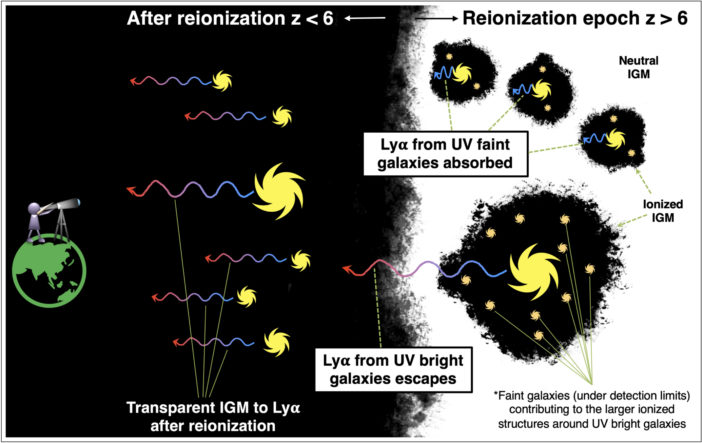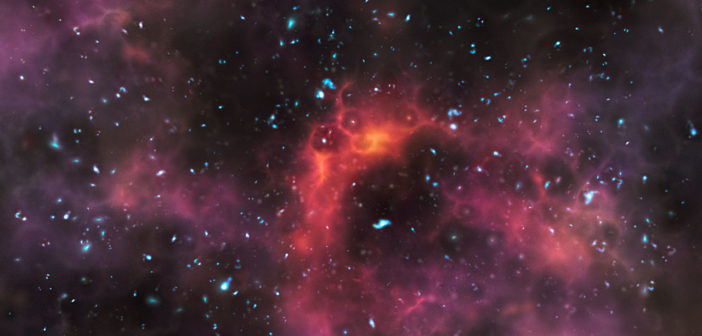Editor’s Note: Astrobites is a graduate-student-run organization that digests astrophysical literature for undergraduate students. As part of the partnership between the AAS and astrobites, we occasionally repost astrobites content here at AAS Nova. We hope you enjoy this post from astrobites; the original can be viewed at astrobites.org.
Title: CLEAR: Boosted Lyα Transmission of the Intergalactic Medium in UV-bright Galaxies
Authors: Intae Jung et al.
First Author’s Institution: The Catholic University of America and NASA’s Goddard Space Flight Center
Status: Published in ApJ
Sometimes the things we don’t see can still give us insight. This strategy of getting clues from both detections and non-detections is common in astronomy, and the non-detections studied in today’s article are used to understand the process of reionization. Sometime during the first billion or so years of the universe, a period of transition called the epoch of reionization took place. During this epoch, the first stars and galaxies formed and began emitting high-energy light that ionized the then mostly neutral hydrogen gas filling the universe. Ionizing radiation can kick off electrons from neutral hydrogen atoms, and in the epoch of reionization this occurred enough to ionize the universe’s gas nearly completely.
A Whodunit Mystery
Early galaxies are a major source of ionizing photons and perhaps the main drivers of this ionization process, so the properties of early galaxies and how they evolved over the first billion years of the universe have great implications for processes within the epoch of reionization. However, understanding how many photons were produced during this epoch and whether they escaped their galaxies and ionized the neutral gas around them is highly dependent on the physical conditions of each galaxy, and it’s therefore challenging to constrain and predict these factors. These challenges lead to more challenges in determining precisely when and where reionization occurred, as well as what kinds of galaxies were primarily responsible.
Tracing the strength of emission from the Lyman-α (n=2 to n=1) transition of hydrogen from early galaxies can give us a sense of the who and where: what sorts of galaxies produced more of the ionizing photons, and were they clustered together or spread out? This line of questioning corresponds to the spatial evolution of reionization. By tracking the fraction of gas that was ionized over time, we can also constrain the temporal evolution of reionization.
Today’s article seeks to get at the whodunit of reionization, focusing on galaxies in the epoch of reionization. More specifically, the authors of today’s article aim to distinguish between brighter and fainter galaxies, particularly within the ultraviolet (UV) range where photons have enough energy to ionize hydrogen. By determining trends between a galaxy’s capacity to emit ionizing photons and the reionization near that galaxy, the authors can test the idea that UV-bright galaxies sit within highly ionized bubbles of gas, and that reionization is accelerated in bubbles containing large numbers of galaxies (illustrated in Figure 1).

Figure 1: Representation of the varied processes during reionization, with the more UV-bright galaxies (larger symbols) sitting in larger ionized bubbles (black) within the neutral gas (white). The ionized bubbles create an environment for the Lyman-α photons to escape and ionize the surrounding gas more easily. More UV-faint galaxies likely exist in the galaxy overdensities within the bubbles but are too faint to be detected with the current dataset. [Jung et al. 2022]
Inequivalent Equivalent Widths
The article seeks to answer one main question: is there any evolution of Lyman-α emission in epoch of reionization galaxies with respect to the UV brightness of those galaxies? To help answer this, the authors measure the strength of Lyman-α emission with a quantity called equivalent width as function of both redshift and the intrinsic UV brightness of the galaxy. Their sample contained a few hundred galaxies with detailed spectroscopic observations as well as new data from the Hubble Space Telescope. With these data, the team searched for any signal (continuum) or Lyman-α emission lines, but they found no convincing Lyman-α emission or continuum-detected galaxies.
Still, these non-detections can help constrain the strength of Lyman-α emission coming from the galaxies. Given the sensitivity of the observations, the authors could (or even should) have detected galaxies if there is no redshift evolution of equivalent width before and after the end of the epoch of reionization (redshift z ~ 6). This basically rules out the existence of strong Lyman-α emission (in other words, high equivalent widths) in this sample, which included more UV-faint galaxies than the sample detected in previous work.
By comparing the detected and non-detected sources and running simulations of mock observations, the authors find some evidence that the Lyman-α emission line strength evolves differently for bright and faint galaxies through the epoch of reionzation. Their analysis is consistent with a picture where reionization is spatially inhomogeneous with large ionized bubbles made by bright galaxies with boosted Lyman-α transmission (Figure 1). The authors note that reionization is probably fairly complicated, with large spatial and temporal variations. Nonetheless, while we can learn something from what we don’t see, the now-operating JWST and other next-generation telescopes will be sensitive to fainter and more distant galaxies, allowing us to get a clearer picture of the epoch of reionization.
Original astrobite edited by Evan Lewis.
About the author, Olivia Cooper:
I’m a third-year grad student at UT Austin studying the evolution of massive galaxies in the first two billion years. In undergrad at Smith College, I studied astrophysics and climate change communication. Besides doing science with pretty pictures of distant galaxies, I also like driving to the middle of nowhere to take pretty pictures of our own galaxy!
